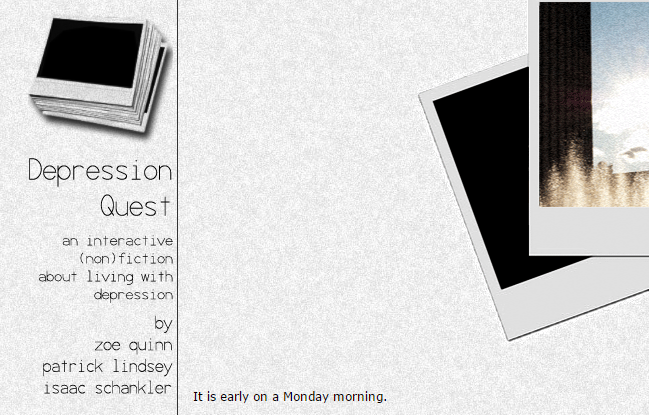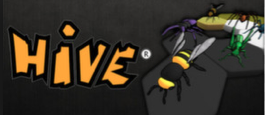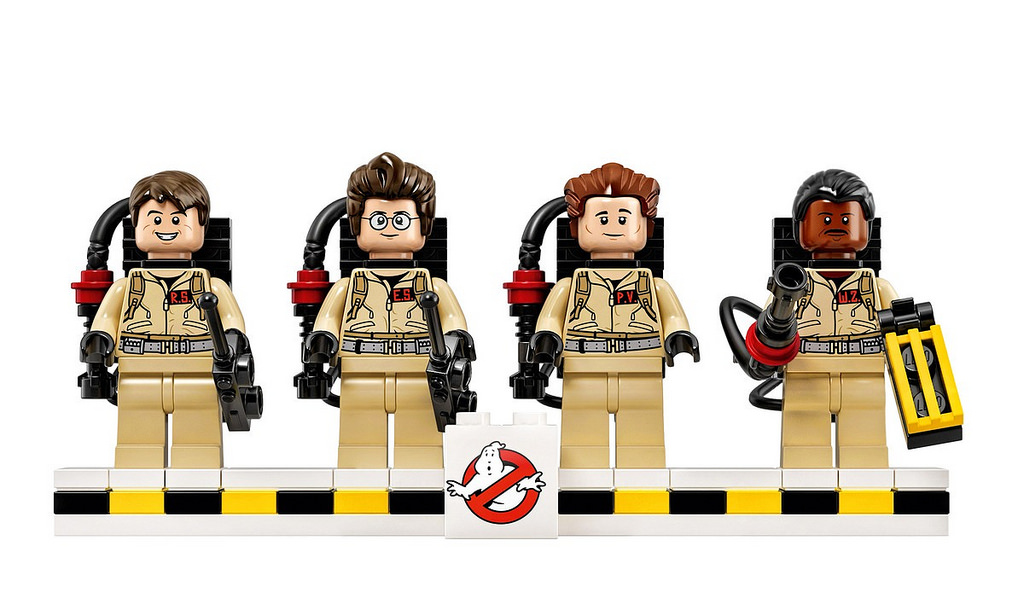I came across an article the other day by Hannah Dwan called “Slicing Up Eyeballs: Abject in Gaming,” in which Dwan discusses the manner in which Julia Kristeva’s conception of abjection is vital for the horror genre and is especially representable in video games:
Horror is a genre that, despite the fear it can induce, remains popular across mediums. From the scary stories of childhood, to the many films that get pumped out of Hollywood year on year, horror is nothing if not durable. It took until 1980, however, for the question of why it’s popular to be addressed in a worthy manner, by Julia Kristeva in her book, Powers of Horror: An Essay on Abjection. Powers of Horror detailed the abject, a concept that played upon both Freudian and Lacanian theories to explore its pervasive presence across art forms. While not discussed by her, games present another medium for the abject.
Regardless of the medium, though, Dwan argues that, today, “[g]iving the reader a means to experience abjection while remaining safe and able to walk away is an important side to modern media.” And, again, Dwan extends her discussion of abjection in modern media by specifically highlighting the manner in which it is utilized in video games (specifically referencing games like Rules of Rose, Bloodborne, and The Binding of Isaac), pointing out that “Kristeva couldn’t have seen the oncoming new form of media that would embrace the abject and offer perhaps the most direct way to experience this limbo between identities without exposing ourselves to true abjection: video games.”
Dwan expands on Kristeva’s definition of the abject, explaining that it “literally means ‘being cast off,’” and is “used to refer to the casting off of the disgusting imagery or actions that can threaten a sense of identity.” And Dwan makes use of one particular excerpt from Powers of Horror to exemplify Kristeva’s definition of abjection, which I’d like to reproduce here as well:
A wound with blood and pus, or the sickly, acrid smell of sweat, of decay, does not signify death. In the presence of signified death—a flat encephalograph, for instance—I would understand, react, or accept. No, as in true theater, without makeup or masks, refuse and corpses show me what I permanently thrust aside in order to live. These body fluids, this defilement, this shit are what life withstands, hardly and with difficulty, on the part of death. There, I am at the border of my condition as a living being.
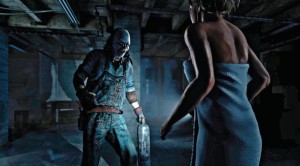 What happens as a result of this thrusting aside, Dwan argues, is “a process of catharsis—the abject reaction itself. Fainting, vomiting, and certain abject reactions can elicit the pleasure that catharsis brings about, while stepping back from this border and solidifying a sense of identity, separating the concept of the self and the grotesque other.” Thus, as Dwan sees it, the abject—especially the abject that we see in horror—allows us to form a sense of identity, a sense of self, in opposition to the grotesque and the abject.
What happens as a result of this thrusting aside, Dwan argues, is “a process of catharsis—the abject reaction itself. Fainting, vomiting, and certain abject reactions can elicit the pleasure that catharsis brings about, while stepping back from this border and solidifying a sense of identity, separating the concept of the self and the grotesque other.” Thus, as Dwan sees it, the abject—especially the abject that we see in horror—allows us to form a sense of identity, a sense of self, in opposition to the grotesque and the abject.
But what happens when one occupies a space of abjection? What happens when one is abject?
I ask these questions because, the thing is, while all this is true, I think it’s also important to point out that Kristeva’s definition of abjection also constructs it as ambiguous. Indeed, while Kristeva does define the abject as a representation of that which we fear and reject most, as “that of being opposed to I,” she also argues that this oppositionality is one that not only defines the dominant ideology (by being the Other against which normativity is constructed) but that also challenges this ideology at the same time. This is why Kristeva finds the corpse to be one of the most exemplary abject figures—because the corpse no longer contains human life but retains human form, thereby causing us to seek to reject it, to cast it out, in order to continue to live. And this is why the abjection of the corpse is ontologically significant—it is an inherently ambiguous reminder of death in that we seek to cast it off and yet cannot be rid of it; it is, then, as Kristeva puts it, “death infecting life.” Thus, abjection, as exemplified by the corpse, is not defined solely through its being disgusting, or unclean, or nauseating but also through the fact that its repugnance disturbs our orderly constructions of identity by not respecting their borders. In other words, Kristeva says that the abject the “in-between, the ambiguous, the composite.”
So who becomes marginalized for their disturbance of these constructions of identity, order, and rules? Who becomes cast off, banished, abjected for occupying ambiguous, in-between spaces?
Indeed, these questions are some of those that Barbara Creed takes up In The Monstrous-Feminine: Film, Feminism, Psychoanalysis, for Creed analyzes the manner in which Kristeva’s theory of abjection often comes to be rendered in gendered ways in the horror genre. As Creed points out, it would seem that woman’s abjection comes to be defined through her sexuality, her motherhood, and her reproductive functions. And while Creed uses this discussion of abjection and gender to analyze film and the horror genre, her analysis of the manner in which women are abjected can, of course, be applied to other textual representations as well, including that of video games.
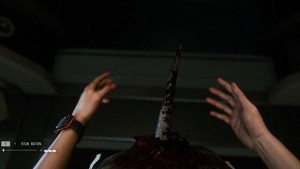 We see the abject in games like Among the Sleep, in which motherhood is rendered monstrous and villainous through the abject figure of the banshee. We see it in games like Alien: Isolation, in which our abject terror is translated through the figure of a woman, Amanda Ripley, who spends most of her time hiding or being killed in gruesome ways by the Xenomorph that stalks her through the corridors of Sevastopol Station, deaths that highlight the vulnerability and breakability—and thus the possibility for abject death—of the body. And we see it in games like Until Dawn, too, which similarly highlights this vulnerability in the scenes in which Sam flees her potential killer in nothing but a towel, scenes that are surrounded by others that contain a cornucopia of guts and gore.
We see the abject in games like Among the Sleep, in which motherhood is rendered monstrous and villainous through the abject figure of the banshee. We see it in games like Alien: Isolation, in which our abject terror is translated through the figure of a woman, Amanda Ripley, who spends most of her time hiding or being killed in gruesome ways by the Xenomorph that stalks her through the corridors of Sevastopol Station, deaths that highlight the vulnerability and breakability—and thus the possibility for abject death—of the body. And we see it in games like Until Dawn, too, which similarly highlights this vulnerability in the scenes in which Sam flees her potential killer in nothing but a towel, scenes that are surrounded by others that contain a cornucopia of guts and gore.
As Dwan says, “Horror, disgust, violence, and atrocities are not jokes, they are not ideas to be gamified. Instead, they are ideas and emotions to be used to promote this catharsis of abjection, to explore the realm between us and the other, to strengthen our sense of identity by witnessing and removing the abject monstrosities.” And while it’s important to highlight, as Dwan does, the significance of abjection in the horror genre, it’s also important to stress, as I’ve hoped to do (or, at least, begin to do) here, the fact that abjection often comes to be defined in gendered ways (and, often, raced ways as well, as Until Dawn reveals in its problematic representations of Native Americans and Native American culture). Doing so allows us to pay more attention to who it is horror texts are perpetually casting off, who it is they are marginalizing, and who it is they are characterizing as abject, which then allows us to pay more attention to what implications such representations of abjection have for the way we think about identity and representation.

